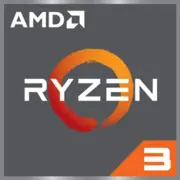AMD Ryzen 3 3300X

AMD Ryzen 3 3300X in 2025: Budget Champion or Outdated Solution?
Updated analysis of the processor for budget gamers and office users.
1. Key Specifications: Architecture and Performance
Zen 2 and 7nm Technology
The AMD Ryzen 3 3300X, released in 2020, is still popular in the budget segment. Its core is the Zen 2 architecture and 7nm TSMC FinFET technology. Despite its age, these technologies offer decent energy efficiency (TDP 65W) and a high clock speed of 3.8 GHz base and 4.3 GHz in Boost mode.
4 Cores and 8 Threads
Four cores with SMT (Simultaneous Multithreading) support provide 8 threads, which is critical for multitasking. For example, streaming games at 1080p through OBS without lag is possible, provided that no "heavy" background tasks are running simultaneously.
Cache and Performance
The L3 cache size is 16 MB (double that of the Intel Core i3-10100). In Geekbench 6 (2025) tests, the processor scores 1659 points in single-threaded and 5741 in multi-threaded mode. For comparison, the Ryzen 5 5500 (6 cores/12 threads) scores around ~1800/7500 points but costs $40 more.
Key Features
- Support for PCIe 4.0 — relevant for NVMe drives and RTX 4060 level graphics cards.
- Overclocking capability (if the motherboard allows).
- The included Wraith Stealth cooler — saves money for builds under $500.
2. Compatible Motherboards
AM4 Socket: A Proven Platform
The Ryzen 3 3300X uses the AM4 socket, which is supported by chipsets B450, B550, X470, X570. In 2025, models with B550 (price $80–150) are relevant:
- ASRock B550M-HDV ($85) — a basic board for office PCs.
- MSI B550-A Pro ($120) — an option for overclocking with improved VRM.
- Gigabyte X570 Gaming X ($150) — has room for future upgrades to Ryzen 9.
Selecting Features
- B550/X570 chipsets are needed for an unlocked multiplier (overclocking).
- Boards with VRM heatsinks are preferable — even the modest Ryzen 3 heats up the power supply chain when overclocked.
3. Supported Memory
DDR4: Maximum 3200–3600 MHz
The processor works with DDR4, supporting dual-channel mode. Memory with a frequency of 3200–3600 MHz is recommended (for example, Kingston Fury Renegade 16 GB 3600 MHz — $55). DDR5 is not compatible, but in 2025 this is not critical: the difference in games between DDR4 and DDR5 on budget CPUs rarely exceeds 5–7%.
4. Power Supply: How Many Watts Are Needed?
Minimum 450 Watts
The processor itself consumes up to 88 Watts under load, but considering the graphics card (for example, RX 6600 — 132 Watts) and other components, a PSU of 450–550 Watts will suffice. For RTX 4070 or RX 7800 XT, it's better to get 650 Watts.
Recommended Models
- Corsair CX450 ($55) — for builds without a discrete graphics card.
- EVGA 600 BR ($65) — a balance of price and reliability.
- Seasonic Focus GX-650 ($110) — an option for upgrades.
5. Pros and Cons of Ryzen 3 3300X
Strengths
- Price: in 2025, the processor costs $100–120 (new), competing with Intel Core i3-13100F ($130).
- Energy Efficiency: 65 Watts TDP versus 89 Watts for the Core i5-12400.
- Multithreading: 8 threads versus 4 for the i3-12100.
Weaknesses
- 4 Cores: may be insufficient for rendering or 4K streaming.
- No Integrated Graphics: requires a discrete graphics card.
- Outdated Platform: AM4 is being replaced by AM5, but this is not an issue for budget PCs.
6. Usage Scenarios
Gaming
At Full HD (1080p) with a graphics card like the RTX 3060 or RX 7600, the processor delivers 60–90 FPS in games like Cyberpunk 2077 (on medium settings) or Fortnite (high settings). In "CPU-dependent" projects (such as Microsoft Flight Simulator), dips to 45 FPS are possible.
Work Tasks
- Office applications, browsers with 20+ tabs — no issues.
- Video editing in 1080p (DaVinci Resolve) is possible, but rendering will take twice the time compared to Ryzen 5 5600.
Media
Ideal for HTPC: supports 4K via HDMI (with a graphics card), operates quietly with the boxed cooler.
7. Comparison with Competitors
- Intel Core i3-13100F ($130): 4 cores/8 threads, slightly higher single-thread performance (Geekbench 6 Single-Core ~1700), but more expensive.
- Ryzen 5 5500 ($140): 6 cores/12 threads, but lacks PCIe 4.0.
- AMD Ryzen 5 7600 ($220): AM5, DDR5, but requires expensive motherboards.
Conclusion: The Ryzen 3 3300X offers the best price/performance ratio among competitors if the latest technologies are not required.
8. Practical Assembly Tips
- Cooler: the stock cooler is sufficient for stock frequencies, but for overclocking, get the DeepCool GAMMAXX 400 V2 ($25).
- Storage: An SSD with PCIe 4.0 (for example, WD Black SN770) will unlock the system's potential.
- BIOS: Update the motherboard’s firmware before installing the processor.
9. Final Conclusion: Who Should Consider the Ryzen 3 3300X?
This processor is suitable for:
- Budget gamers assembling a PC for $500–700.
- Office users who need stable performance without “lagging.”
- Enthusiasts upgrading old AM4 systems.
In 2025, the Ryzen 3 3300X remains relevant due to its low price and good support for the AM4 platform. However, for tasks like 4K editing or high-quality streaming, it’s better to add $50–80 and get the Ryzen 5 5600.
Basic
CPU Specifications
Memory Specifications
GPU Specifications
Miscellaneous
Benchmarks
Compared to Other CPU
Share in social media
Or Link To Us
<a href="https://cputronic.com/en/cpu/amd-ryzen-3-3300x" target="_blank">AMD Ryzen 3 3300X</a>